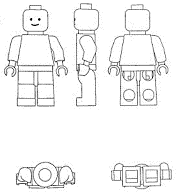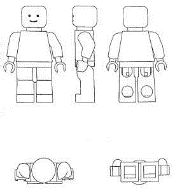On 6 December 2023, the General Court of the European Union dismissed two invalidity actions brought by BB Services GmbH against two three-dimensional trademarks relating to toy figures, on the grounds that their shapes are not exclusively dictated by the nature of the product itself or by a shape necessary to obtain a technical result (General Court of the European Union judgements T-297/22 and T-298/22).


No. 50450 No. 50518
Article 7(1)(e)(i) and (ii) of Regulation (EU) 2017/1001 states that « (1) The following shall not be registered: […] (e) signs which consist exclusively of: (i) the shape, or another characteristic, which results from the nature of the goods themselves; (ii) the shape, or another characteristic, of goods which is necessary to obtain a technical result; […] ».
The General Court of the European Union has ruled that these grounds for refusal of registration must be rejected where the trademarks have at least one essential feature which is not imposed by the very nature of the product or where there is at least one essential feature of the shape which is not necessary to obtain a technical result.
To assess the validity of trademarks, the General Court first analyzes the nature of the product and then determines its essential characteristics in order to determine (i) whether there is at least one essential characteristic that is not imposed by the very nature of the product and (ii) whether there is at least one essential characteristic of the shape that is not necessary to obtain a technical result.
With regard to the nature of the product, it considers that the trademarks are both « toy figures », the purpose of which is play, and therefore non-technical, and also « interlocking building figures », which are technical in nature due to their interlocking nature and their modularity with the trademark proprietor’s Lego® construction system.
In assessing the essential characteristics of the three-dimensional trade mark, that is to say, its most important elements, the General Court points out that account must be taken not only of the graphic representation of the trade mark but also of other relevant elements relating to the nature of the actual product, in particular the public’s knowledge of the intervener’s modular construction system « even if they are not visible in the graphic representation » of the trademark.
On this basis, the General Court identified as essential characteristics of the products not only the « non-technical » characteristics that give them a human appearance (the head, torso, arms and legs), but also the « technical » characteristics specific to their nature as « interlocking building figures » (the stud on the head, the hooks on the hands, the holes in the back of the legs and under the feet of the figure).
(i) On the first ground, in order to determine whether or not the three-dimensional trademark consists exclusively of the shape, or another characteristic, imposed by the very nature of the product, the General Court notes that the creator of the figures enjoys considerable freedom of design.
It then deduces that the decorative or imaginative elements (the cylindrical or « barrel » shape of the figure’s head, the short, rectangular shape of the neck and the flat, angular trapezoidal shape of the torso, as well as the specific shape of the arms with the hands and the legs with the feet) are not inherent to the generic function of a toy figure or the generic function of an interlocking building figure.
It therefore concludes that the mark is registrable.
(ii) On the second ground, the General Court points out that, « in examining the functionality of a sign consisting of the shape of goods, once the essential characteristics of the sign have been identified, it is only necessary to assess whether those characteristics perform the technical function of the goods concerned ».
It went on to state that « the ground for refusal set out in Article 7(1)(e)(ii) of Regulation No 40/94 cannot apply when there is at least one essential characteristic of the shape which is not necessary to obtain a technical result, with the result that the contested trade mark does not consist « exclusively » of the shape necessary to obtain a technical result », so that the contested trademark does not consist « exclusively » of the shape necessary to obtain a technical result, that is to say « when the trade mark applied for, or which is contested, relates to a product shape in which a non-functional element, such as a decorative or imaginative element, plays an important role ».
In this respect, it considers that, although the technical purpose linked to stackability and modularity is achieved by essential features (the hooks on the figure’s hands and the holes under its feet and at the back of its legs) there are also other essential features (the cylindrical or « barrel » shape of the head of the figure in question, the short, rectangular shape of the neck and the trapezoidal, flat, angular shape of the torso, as well as the specific shape of the arms with the hands and that of the legs with the feet) which are not necessary to achieve a technical purpose.
Consequently, the General Court also rejects the ground for refusal of registration relating to the form necessary to obtain a technical result.
Lessons to be learned from this decision :
- A concrete assessment of the product that is the subject of a three-dimensional trade mark application, which does not result solely from the graphic representation of the trademark, but also from other factors relating to the nature of the concrete product: we will therefore take into account the non-visible elements, such as the technical elements and mechanisms contained in the product, which are perceived by the public when using it. This approach had already been adopted in previous decisions (judgment of 24 October 2019, Shape of a cube with faces having a grid structure, T-601/17), [judgment of 12 November 2008, The lower face of the brick in the case of the « Lego brick », T-270/06);
- The definition of the essential characteristics of a three-dimensional trademark, which may be « technical » or « non-technical » and which must be assessed in the light of the nature of the specific product; here again, the General Court relies on the earlier case-law which it cites in its decision (judgments of 10 November 2016 in Case C-30/15 Simba Toys v EUIPO and of 23 April 2020 in Case C-237/19 Gömböc);
- The designer’s degree of freedom when designing the product in order to be able to identify decorative or imaginative elements that are not imposed by the very nature of the product or necessary to achieve a technical purpose. This is the criterion used to assess the individual character of a design.
This decision may encourage applicants to protect their star products with decorative or imaginative elements as three-dimensional trademarks. However, these products must also be distinctive, i.e. different from the norm and habits of the sector.
Lavoix remains available to answer any questions you may have about this decision.

